Key takeaways:
- Engaging illustrations enhance communication, evoke emotions, and foster connections with audiences.
- Effective illustrations require clear narratives, simple designs, and the use of color psychology to influence emotional responses.
- Utilizing tools like Adobe Illustrator and Procreate can significantly improve the quality and creativity of illustrations.
- Building a cohesive theme through consistent color palettes and styles enhances the overall impact and recognition of illustrations.
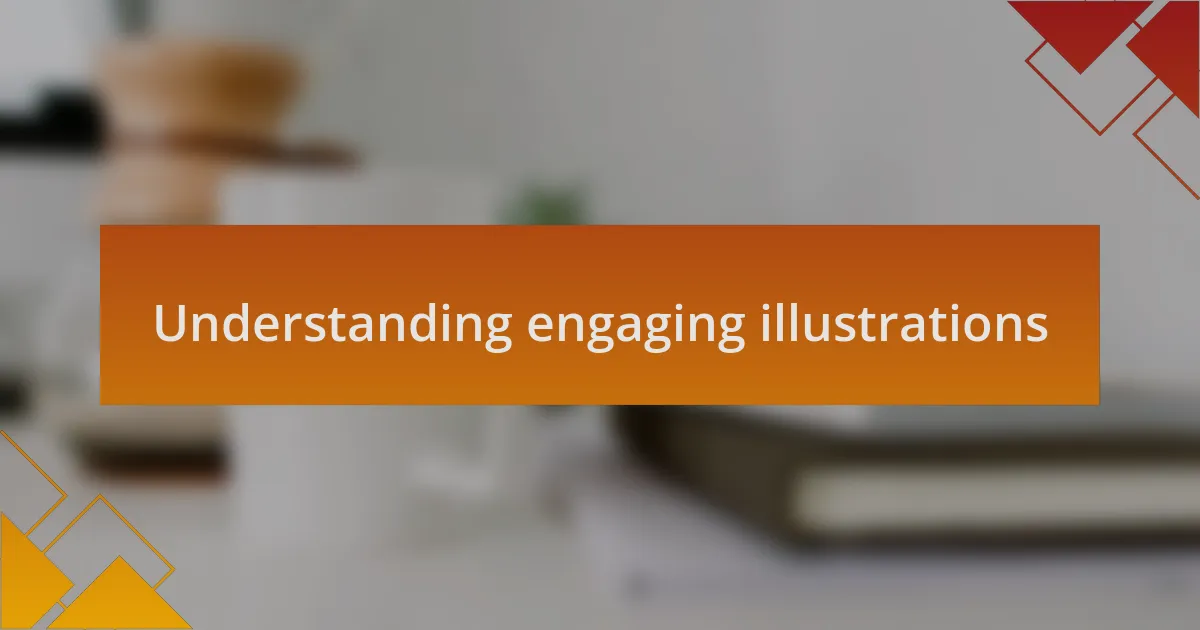
Understanding engaging illustrations
Engaging illustrations can transform a simple message into a vivid narrative that resonates with viewers. I recall a time when I was working on a project that needed to communicate complex ideas. I opted for illustrations that highlighted key concepts, and the difference was palpable; suddenly, my audience was not only interested but also eager to share the content. Isn’t it fascinating how visuals can draw us in, almost as if they’re speaking directly to our experiences?
When I think about the emotional impact of illustrations, I often remember an infographic I came across that beautifully portrayed the journey of independent authors. It struck a chord with me and prompted a sense of connection and passion I hadn’t anticipated. This is the power of engaging visuals; they evoke feelings, ignite curiosity, and encourage a broader conversation. Have you ever felt that spark when looking at a compelling image?
In contrast, bland or overly complicated illustrations can act like a wall between your message and the audience. I’ve seen this firsthand; a confusing design left potential readers puzzled instead of intrigued. What you want is a clear narrative through your illustrations that enhances understanding and invites interaction. Creating illustrations that are both captivating and informative is truly an art form in itself.
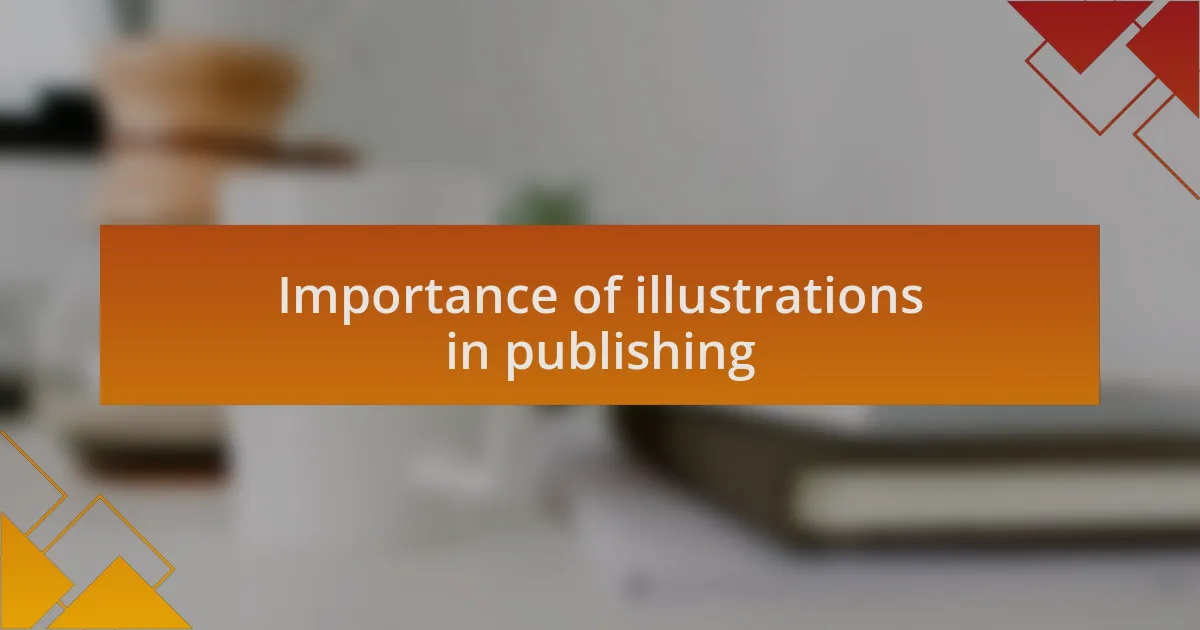
Importance of illustrations in publishing
Illustrations play a critical role in the publishing landscape by bridging the gap between text and the reader’s imagination. I remember a book cover that used a striking illustration to convey its theme, and it made me pick it up instantly. It’s amazing how a single image can encapsulate the essence of a story, inviting readers into a world they can’t resist exploring. Have you ever judged a book by its cover?
Beyond aesthetics, illustrations enhance comprehension and retention. I once designed a promotional poster that combined succinct text with eye-catching visuals to summarize a complex subject. The feedback was overwhelmingly positive; people told me they finally understood the topic after seeing those illustrations. It made me realize how effectively visuals can reinforce our understanding and enhance learning!
Furthermore, illustrations foster a deeper emotional connection with the content. I recall a time when I was involved in a project that featured illustrations showcasing diverse voices within independent publishing. The response was profound; readers expressed feeling seen and represented through those images. Don’t you think that when illustrations reflect the reader’s own experiences, they grow more invested in the narrative? That’s the beauty of engaging illustrations: they create a personable link between the content and the audience.

Techniques for effective illustrations
When creating effective illustrations, one technique that stands out to me is the power of color psychology. I once designed a series of illustrations where I used warmer tones to evoke feelings of comfort and connection. The reactions from viewers were striking; they felt drawn into the artwork, as if it was embracing them. Isn’t it fascinating how certain colors can trigger emotions and influence a viewer’s experience?
Another technique is to maintain simplicity in design. I recall a time I was tasked with illustrating a complex concept for a workshop. By using clear, uncomplicated visuals alongside minimal text, I managed to convey the message effortlessly. The participants appreciated how easy it was to grasp the information. Have you ever stumbled upon a cluttered illustration that left you feeling overwhelmed? Simple designs can often communicate ideas more effectively and allow the viewer to focus on the essence of the message.
Finally, I find that incorporating storytelling elements in illustrations captivates the audience’s attention. In a recent project, I combined sequential images to create a visual narrative that complemented the written content. The viewer journeyed through the illustrations just as they would through a story, feeling invested in the characters and events depicted. Don’t you think that when illustrations tell a story, they not only engage but also resonate with readers on a deeper level?
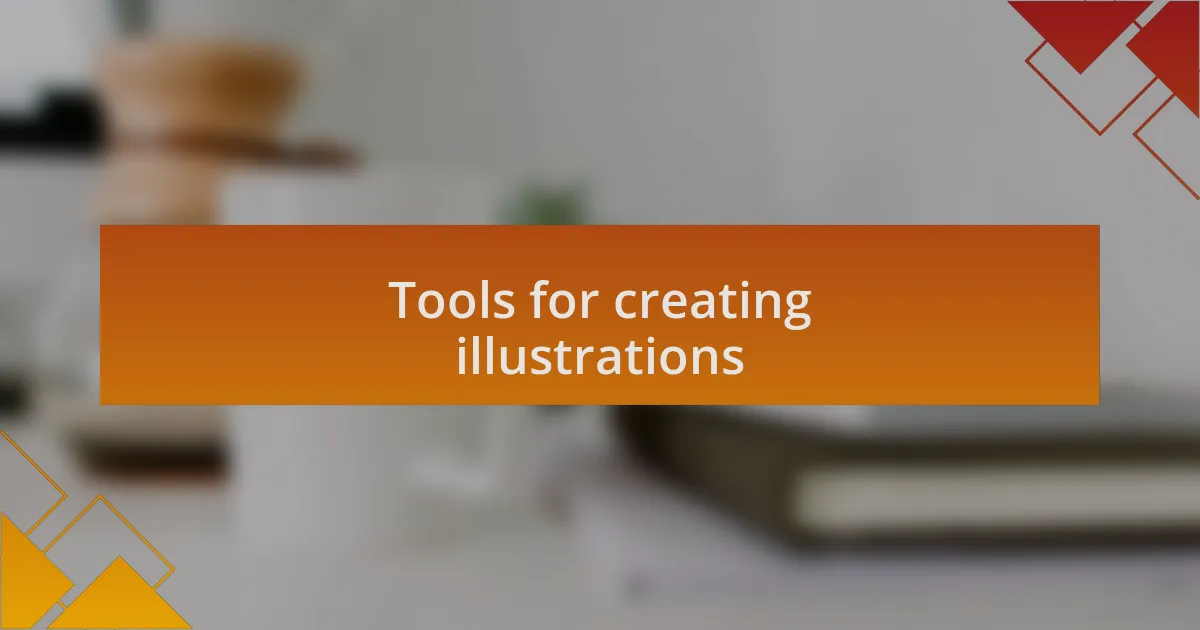
Tools for creating illustrations
When it comes to tools for creating illustrations, I often turn to Adobe Illustrator for its versatility and robust features. I vividly remember the first time I used it; I was amazed by how effortlessly I could create vector graphics that maintained their quality regardless of size. Have you ever struggled with software that limited your artistic expression? Illustrator lets me craft intricate designs with precision, allowing for a satisfying creative flow.
Another tool that has made a significant impact on my illustrations is Procreate. Using my iPad, I can sketch ideas on the go, which has completely transformed my workflow. I still recall sitting in a café, inspired by the surroundings, and bringing my ideas to life in real-time. Isn’t it liberating to have a digital canvas that feels so much like traditional drawing yet provides endless possibilities? Procreate’s user-friendly interface makes it accessible for both beginners and seasoned artists alike.
For those looking to create illustrations that incorporate animated elements, I recommend exploring tools like Adobe After Effects. I took an online course once that focused on bringing static illustrations to life, and it opened up a whole new dimension for my work. The thrill of seeing a character I drew start to move and express emotions was nothing short of exhilarating. How often do you get the chance to see your artwork take on a new form? With After Effects, the possibilities for creativity seem virtually limitless.
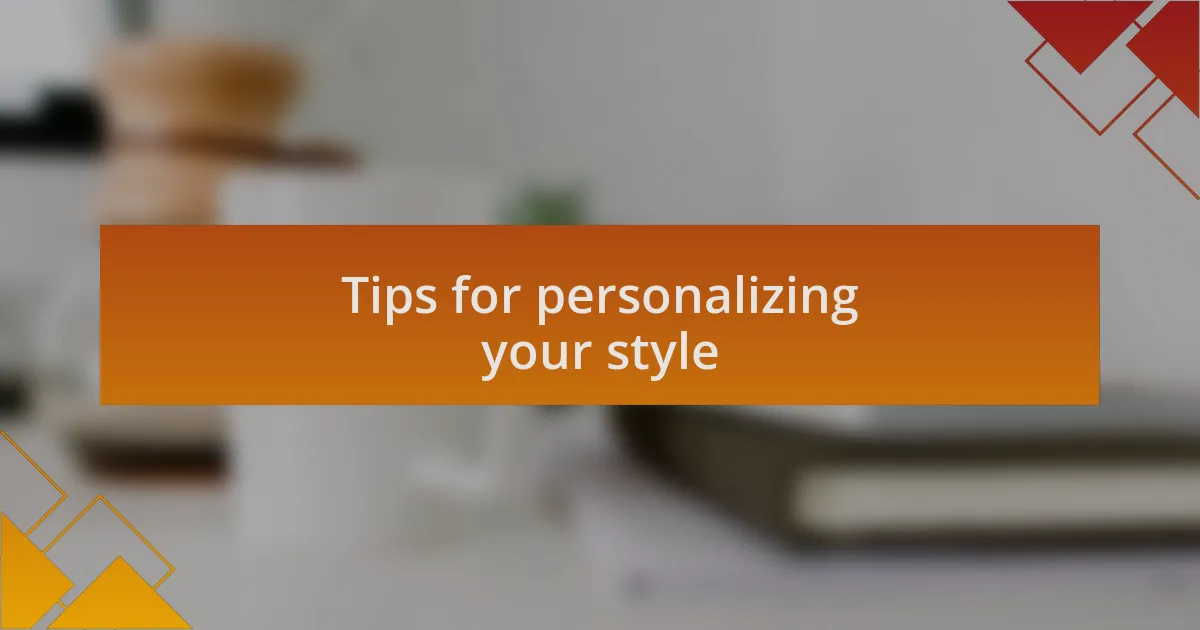
Tips for personalizing your style
Finding your unique style can be one of the most rewarding aspects of illustration. When I first began, I felt lost amidst countless artistic influences. I realized that blending elements from various styles into something uniquely mine was the answer. Have you ever tried to mimic someone else’s work but felt it lacked authenticity? Embracing my quirks and personal preferences significantly enhanced my illustrations’ character.
Another key to personalizing your style is experimenting with different techniques and mediums. I remember a phase where I dabbled in watercolor and digital art simultaneously. The contrasting outcomes taught me so much about texture and depth. Isn’t it amazing how each medium can influence your creative voice? Allowing myself to play, even when the results weren’t what I had envisioned, nurtured a deeper connection to my art.
Lastly, don’t hesitate to incorporate personal experiences into your illustrations. For instance, during a challenging time, I depicted my feelings through abstract shapes and colors. This process not only provided a therapeutic outlet but also resonated profoundly with others. How can your life experiences shape your art? Using your story as a foundation can evoke emotions that resonate with viewers on a personal level.
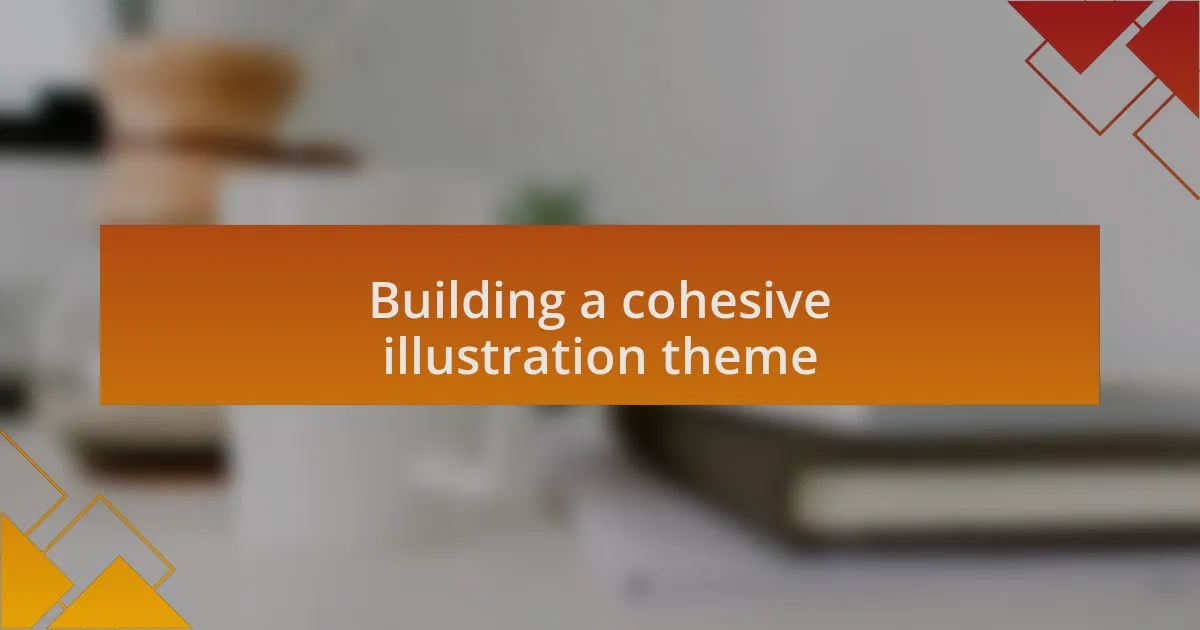
Building a cohesive illustration theme
Building a cohesive illustration theme starts with understanding the core message you want to convey. I often reflect on my projects and ask myself, “What story am I telling through these images?” A consistent theme not only aligns your artwork with your message but also creates a visual narrative that guides your audience through your content. When I curated illustrations for a book on self-discovery, I focused on earthy tones and organic shapes to evoke a sense of growth and grounding, ensuring every illustration reinforced the journey I was portraying.
Color palette is another essential element for creating a cohesive theme. When I worked on an online magazine’s visual identity, I selected a limited palette and surprised myself with how much it unified the illustrations. Have you considered how colors can dictate emotions? By using shades of blue to evoke calmness and balance, my illustrations not only looked consistent but also enhanced the overall reader experience. Consistency in color strengthens your message, leading to a more impactful visual statement.
Lastly, consider the style of your illustrations. I learned firsthand that mixing too many artistic styles can create visual chaos. I once experimented wildly with shapes and line qualities for a personal project, but it felt disjointed. The moment I settled into a simple line-art style, everything clicked, and my illustrations exuded clarity. How do you feel about the styles you use? Creating a signature style, whether it’s playful, minimalist, or detailed, can help your work resonate with your audience, making it instantly recognizable and memorable.

Showcasing illustrations in your work
Showcasing illustrations effectively means integrating them seamlessly into your content. When I published my first digital story, I realized that placing illustrations strategically within the text kept readers engaged. For instance, I paired an illustration with a pivotal moment in the narrative to emphasize its emotional weight. It’s fascinating how a single image can transform the way a reader experiences a scene, inviting them to linger a bit longer.
Another consideration is the size and placement of your illustrations. I once had a vibrant, full-page illustration that almost overshadowed the text, which led to a less-than-optimal reading experience. I learned that sometimes, a smaller illustration positioned alongside the text can draw readers in, allowing them to take in both the words and the visuals harmoniously. Have you thought about how the positioning of your illustrations can guide emotional responses?
Lastly, context is everything. During a project about urban life, I opted for illustrations that mirrored the chaotic energy of the city. By showcasing art that reflected the hustle and bustle, I created a connection with my readers that was both relatable and immersive. It left me wondering: how do your illustrations reflect the themes of your work? Strong thematic connections enhance not only the storytelling but also the emotional impact, giving your audience a visual touchpoint to explore.